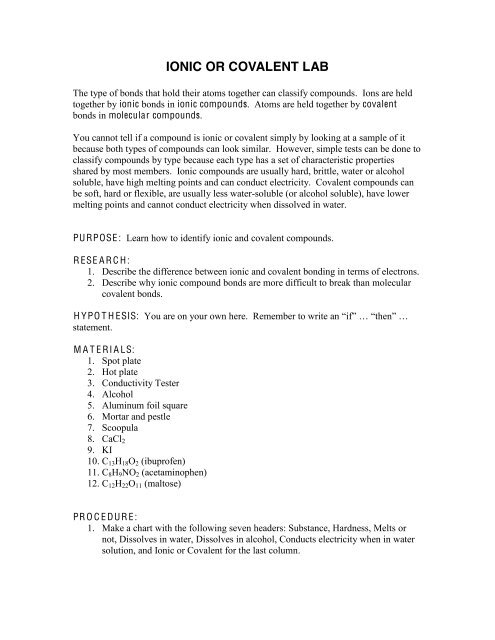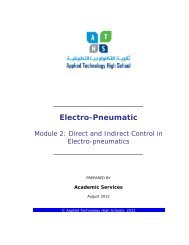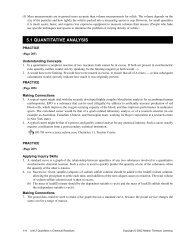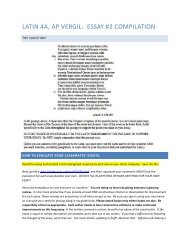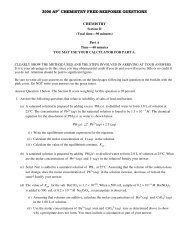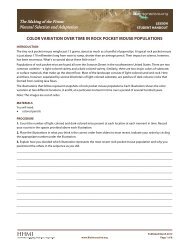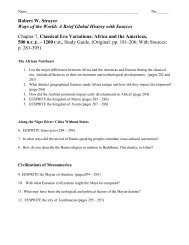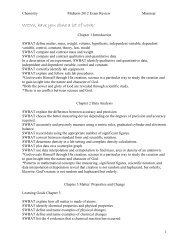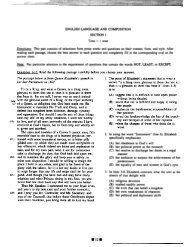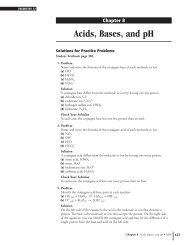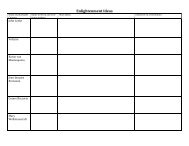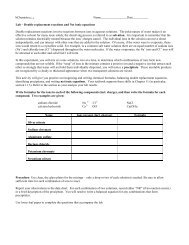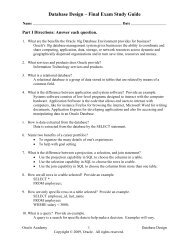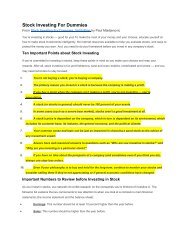You also want an ePaper? Increase the reach of your titles
YUMPU automatically turns print PDFs into web optimized ePapers that Google loves.
<strong>IONIC</strong> <strong>OR</strong> <strong>COVALENT</strong> <strong>LAB</strong><br />
The type of bonds that hold their atoms together can classify compounds. Ions are held<br />
together by ionic bonds in ionic compounds. Atoms are held together by covalent<br />
bonds in molecular compounds.<br />
You cannot tell if a compound is ionic or covalent simply by looking at a sample of it<br />
because both types of compounds can look similar. However, simple tests can be done to<br />
classify compounds by type because each type has a set of characteristic properties<br />
shared by most members. Ionic compounds are usually hard, brittle, water or alcohol<br />
soluble, have high melting points and can conduct electricity. Covalent compounds can<br />
be soft, hard or flexible, are usually less water-soluble (or alcohol soluble), have lower<br />
melting points and cannot conduct electricity when dissolved in water.<br />
PURPOSE : Learn how to identify ionic and covalent compounds.<br />
R ESE A R C H:<br />
1. Describe the difference between ionic and covalent bonding in terms of electrons.<br />
2. Describe why ionic compound bonds are more difficult to break than molecular<br />
covalent bonds.<br />
H YPO T H ESIS: You are on your own here. <br />
statement.<br />
M A T E RI A LS:<br />
1. Spot plate<br />
2. Hot plate<br />
3. Conductivity Tester<br />
4. Alcohol<br />
5. Aluminum foil square<br />
6. Mortar and pestle<br />
7. Scoopula<br />
8. CaCl 2<br />
9. KI<br />
10. C 13 H 18 O 2 (ibuprofen)<br />
11. C 8 H 9 NO 2 (acetaminophen)<br />
12. C 12 H 22 O 11 (maltose)<br />
PR O C E DUR E:<br />
1. Make a chart with the following seven headers: Substance, Hardness, Melts or<br />
not, Dissolves in water, Dissolves in alcohol, Conducts electricity when in water<br />
solution, and Ionic or Covalent for the last column.
2. Feel a small sample of each substance and record on your chart whether it is hard,<br />
brittle or soft. Save this sample on a paper towel to use in Part 1.<br />
Part 1<br />
3. Get a square of aluminum foil and draw six (6) wedge shapes on it. Label the<br />
wedges A, B, C, D, E and F.<br />
4. Place a SMALL sample of each substance in the appropriate wedge of your foil.<br />
5. Place the foil on a hot plate and turn it on high.<br />
6. After a few minutes, observe each section and record on a chart, which substances<br />
have melted and their order.<br />
7. Turn off the hot plate.<br />
Part 2<br />
8. Label six (6) spot plate wells with the letters of the substances.<br />
9. Place a SMALL sample of each substance in the appropriate spot plate well.<br />
10. Fill each well with water from the sink and stir.<br />
11. Repeat procedure with all six substances using alcohol on the another row.<br />
12. Record whether substance dissolved or not on your chart.<br />
Part 3<br />
13. This part will be done as a class demonstration.<br />
14. Lab group 1 will make a solution of substance A, group 2 of substance B, group 3<br />
of substance C, group 4 of substance D, group 5 of substance E, group 6 of<br />
substance F.<br />
15. Fill a 100 mL beaker with 60 mL of water. Dissolve a small amount of your<br />
assigned substance into the beaker.<br />
A N A L YSIS Q U EST I O NS:<br />
1. Use your melting point data to explain the relative strengths of ionic and<br />
molecular covalent bonds.<br />
2. Will the melting point of an ionic compound most likely be higher or lower<br />
when the bond is stronger? What determines the strength of an ionic bond?<br />
(HINT: Will the charge be higher or lower? Will the ion be larger or<br />
smaller?)<br />
3. Look at the halogen family on the periodic table of elements. Note fluorine<br />
and chlorine are gases, bromine is a liquid and iodine is a solid. Every<br />
halogen forms a molecular covalent bond with itself. Ex. F 2 , Cl 2 , Br 2 , and I 2 .<br />
Using the above trend information, what can you conclude occurs as the<br />
number of electrons increases when molecular bonds are formed?<br />
4. Considering the above information, would glucose (C 6 H 12 O 6 ) or maltose<br />
(C 12 H 22 O 11 ) have a higher melting point? Justify your answer.<br />
te a conclusion! Write at least three sentences plus answer questions<br />
on lab rubric.


